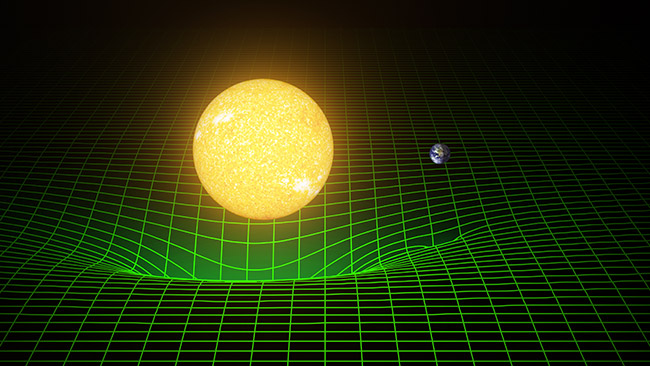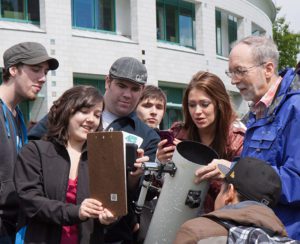Understanding gravitational waves
Picture the universe as a jiggly waterbed mattress
By Lily Raff McCaulou

This sun and Earth grid shows how gravity warps the fabric of space and time, and how the bodies move along paths determined by this geometry. Illustration by Caltech-MIT-LIGO Lab-Tim Pyle
Albert Einstein’s alternative, the general theory of relativity, has held up for decades because the math that supports it works for objects of all sizes. But Einstein’s theory predicts the existence of what he called gravitational waves—and until the Laser Interferometer Gravitational-Wave Observatory (LIGO) detected two chirps in September 2015, there wasn’t any direct evidence they existed.
To understand Einstein’s theory, Shamrell suggests envisioning the universe as the jiggly mattress of a water bed. Setting a bowling ball—the sun—on the bed creates “a dimple in the fabric of space-time,” he said. When a smaller ball—Earth—is placed on the bed, it circles around the bigger ball, not because the two objects have an innate attraction, but because of the curvature of space.
Gravitational waves are the ripples that radiate across the mattress when something cataclysmic happens. The event that led to the discovery last September, for example, was the collision of two black holes—about 29 and 36 times the mass of the sun—in the distant universe, 1.3 billion years ago.
In the 1970s, two scientists found evidence of two black holes spiraling together, getting closer to each other.
“The orbit got tighter, which doesn’t happen unless they’re losing energy,” Shamrell said. “And they were losing energy at the same rate that general relativity would predict if they were sending out gravitational waves.”

Prof. Dick Shamrell, far right, demonstrates to his students how to safely view Venus’ traverse across the sun.
Click here to see warped space and time collide
The first-ever physical evidence of gravitational waves came when the twin LIGO detectors noted the “chirp, chirp” of exactly such a disturbance. The timing was seven milliseconds apart, due to the distance between Washington and Louisiana, where the labs are located. Scientists spent the next five months checking their calculations and ruling out other possible causes for the detection.
Another way of thinking about the discovery is that while we’ve long had technology to look at space, LIGO gives researchers a way to listen to it. This new sense allows scientists to detect objects that are too far away, and events that happened too long ago, to see. The gravitational wave detected in September was “like a bell ringing and then stopping,” Shamrell said.
“It fit very closely our predictions of what two black holes spiraling into each other would look like as they basically shook the universe to its foundation with these gravitational waves,” Shamrell said.
Lily Raff McCaulou is a journalist living in Portland, Ore. She is the author of Call of the Mild: Learning to Hunt My Own Dinner, which the San Francisco Chronicle named one of the best books of 2012. She has written for The New York Times and The Atlantic.
8/12/2016



